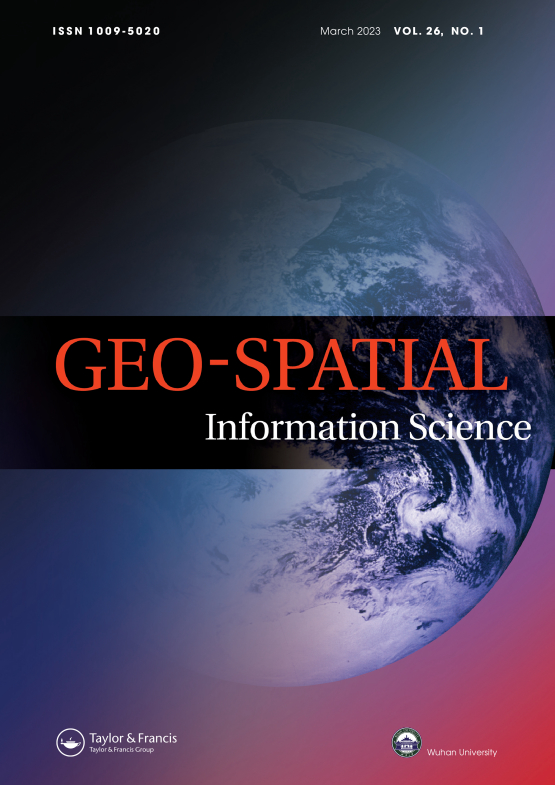Submit a Manuscript to the Journal
Geo-spatial Information Science
For a Special Issue on
Advancing Geospatial Image Perception and Understanding Under Challenging Real-World Conditions
Manuscript deadline


Special Issue Editor(s)
Qifeng Yu,
National University of Defense Technology, China
yuqifeng@nudt.edu.cn
Erting Pan,
National University of Defense Technology, China
panerting@whu.edu.cn
Zhang Li,
National University of Defense Technology, China
lizhang08@nudt.edu.cn
Leyuan Fang,
Hunan University, China
leyuan_fang@hnu.edu.cn
Pedram Ghamisi,
Helmholtz-Zentrum Dresden-Rossendorf, Germany
p.ghamisi@hzdr.de
Jiayi Ma,
Wuhan University, China
jyma2010@gmail.com
Max Mehltretter,
Leibniz University Hannover, Germany
mehltretter@ipi.uni-hannover.de
Xiang Li,
University of Reading, UK
x.li7@reading.ac.uk
Advancing Geospatial Image Perception and Understanding Under Challenging Real-World Conditions
Geospatial image analysis has emerged as a cornerstone for mission-critical applications across diverse domains, ranging from urban modeling (e.g., multi-sensor UAV navigation in degraded visibility) to dynamic environmental monitoring (e.g., near-real-time disaster response), and the rising paradigm of foundation model-driven scene interpretation. These applications fundamentally depend on extracting accurate geometric, spatial, temporal, and spectral information from imagery. Unfortunately, their real-world deployment faces three constraints:
- Undesirable Imaging Conditions. Atmospheric interference (clouds/aerosols) and adverse illumination (shadow/low-light), compromise radiometric fidelity, inducing critical detail loss.
- Single-Sensor Limitations. Inherent spatial-spectral-temporal resolution trade-offs restrict multi-dimensional, multi-scale scene representation.
- Generalization Gaps. Sparse targets, temporal dynamics (e.g., seasonal shifts), and scarce annotations hinder cross-scene adaptability.
To break through these dilemmas, we are now issuing a call for papers to further advance the research and solutions in this critical area. We invite researchers, scholars, and practitioners to contribute original research papers that explore the latest developments, innovative methods, and practical applications related to geospatial image perception and understanding, particularly within the context of challenging real-world conditions.
Submissions may cover, but are not limited to the following topics:
- Methods for image quality improvement (e.g., dealing with noisy, low-resolution, rain, or fog/cloud/shadow conditions)
- Techniques for integrating multi-dimensional, multi-temporal, or multi-sensor (e.g., optical, infrared, radar, SAR) data
- Methods for robust and fast image registration on multi-source, multi-temporal images
- Methods for image augmentation and synthesis
- Methods for learning from limited labeled data (e.g. few-shot learning, meta-learning, transfer learning) or without any labeled data (e.g. self- and unsupervised learning)
- Methods for 3D reconstruction and visual SLAM under challenging conditions
- Approaches for small, time-sensitive or deformable object/instance detection, location, and tracking in 2D and 3D
- Emerging and advanced techniques (e.g., foundation models, large language models, visual-language models) for geospatial image perception and scene understanding
- Methods for image-based uncertainty estimation and failure prediction (e.g. out-of-distribution detection)
- New benchmark datasets under restricted real-world scenarios
- Reviews and surveys related to geospatial image perception and understanding
- Area-specific applications (remote sensing, vision navigation, image measurement, etc.)
Submission Instructions
All submissions will be peer reviewed according to the Geo-spatial Information Science (GSIS) guidelines. Submitted manuscripts should not have been published or be under review elsewhere. Prospective authors should consult the Instructions for Authors page on the journal homepage for guidelines and information on paper formatting and submission.
Authors should submit manuscripts using the GSIS submission portal. Please select “Image Perception and Understanding amidst Restricted Real-World Scenarios” in the space provided on the submission form for the name of the special issue.
